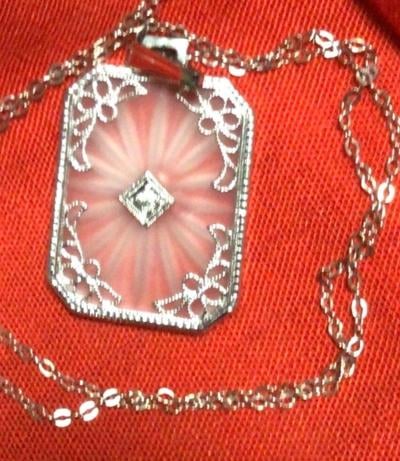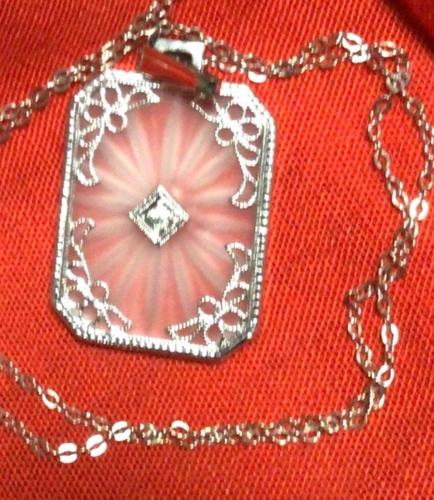When I see everyone from 20-something major league baseball players to sensational senior women reintroducing pearls to their everyday (and team uniform) wardrobes, you know that the values are going to rise with the collecting tides.
After pearls, cameos representing figures from the ancient Greek and Roman age are all the rage, with collectors searching near and far — and, of course, online — for the best-carved, most interesting and intricate examples of the pendant and pin art form.
However, another type of jewelry is giving pearls and cameos a run for their money. It is camphor glass jewelry.
Art deco jewelry pendants made of exotic camphor glass and oversized brooches set in sterling silver or white gold are the newest vintage objects of adornment that are impressing collectors.
The classic look of camphor glass has been bringing renewed excitement to the world of jewelry.
The beginnings of camphor glass jewelry started with rock crystal in 17th-century England. In an effort to show loyalty to King Charles I, who was executed in 1649, his supporters began to wear rock crystals, also known as Stuart crystals, as jewelry.
Later, in the Victorian era, these crystals were found to be acceptable pieces of mourning jewelry, often worn to recognize and memorialize the passing of a loved one.
In the 1800s and early 1900s, rock crystals found their place at the center of fine jewelry designs the world over. Rock crystals were used in the 19th century on necklaces, bracelets, rings, pendants and brooches.
Important French jewelers like Cartier, Boucheron and Fouquet used rock crystals in their 1920s-era jewelry designs. Although carved crystals had an unclear and cloudy look that was growing in popularity, carving crystal was a daunting task, and artisans and glass makers tried to imitate the look by experimenting with other glass types. Their experiments led to camphor glass.
Easy to mass produce, camphor glass became a welcome addition to the host of materials used in jewelry making. Camphor glass makers tried to imitate rock crystal.
How did they do it?
Camphor glass is achieved by treating clear glass with hydrofluoric acid vapors to get a frosted finish. This frosted or cloudy finish was a desired look, and today it is making a big comeback in the jewelry collecting world. The word camphor refers to the resin extracted from camphor trees, which has a cloudy transparency which acid-treated glass resembles. The exotic nature of the jewelry pieces were of interest to art deco socialites and flappers alike.
Most pieces of camphor glass jewelry feature a central star design in the glass. A rectangular or square piece of camphor glass would be traditionally set in a silver-plated, sterling silver or white gold filigree setting with a central diamond placed to attract the eye.
Outside might be overcast but inside, orchids are in the spotlight for Susquehanna Orchid Society’s annual show.
The camphor glass was cloudy yet attractive and the diamond was clear and sparkling, giving the piece of jewelry an interesting and contrasting appearance.
The addition of the small diamond recalled cameos, which also added a tiny diamond to the design. But the glass offered a more contemporary look.
With a Ph.D. from Penn State University, Lori Verderame is an antiques appraiser, author and award-winning TV personality who has appeared on the TV shows “The Curse of Oak Island” and “Pawn Stars Do America.” You can watch her “Real Bargains” show at YouTube.com/DrLoriV. She gives appraisal information at DrLoriV.com or call 888-431-1010.



![Dr. Lori: 'Friends' and 'American Idol' collectibles connect TV to coffee culture [antiques column]](https://bloximages.newyork1.vip.townnews.com/lancasteronline.com/content/tncms/assets/v3/editorial/b/22/b229e4f0-ab49-11ee-b867-13f54ae18ed1/6597257e7d641.image.jpg?resize=150%2C115)
![Dr. Lori: Vintage wagons, sleds of interest to collectors [antiques column]](https://bloximages.newyork1.vip.townnews.com/lancasteronline.com/content/tncms/assets/v3/editorial/3/c2/3c2aa7e6-8fc2-11ee-8b4a-23637ba82e99/6568f5d117317.image.jpg?resize=150%2C106)
![Dr. Lori: 1960 JFK campaign memorabilia lures collectors [antiques column]](https://bloximages.newyork1.vip.townnews.com/lancasteronline.com/content/tncms/assets/v3/editorial/5/6a/56a3f260-79c6-11ee-9e7b-bbf7d58802b9/654413c5e038d.image.jpg?crop=1189%2C1207%2C23%2C416&resize=197%2C200&order=crop%2Cresize)
![1,000 orchids bloom this weekend in an indoor escape from winter at Hershey Gardens [photos]](https://bloximages.newyork1.vip.townnews.com/lancasteronline.com/content/tncms/assets/v3/editorial/b/4f/b4f1b06c-c095-11ee-876b-b7c385efdc8a/65bae07356270.image.jpg?resize=150%2C134)


